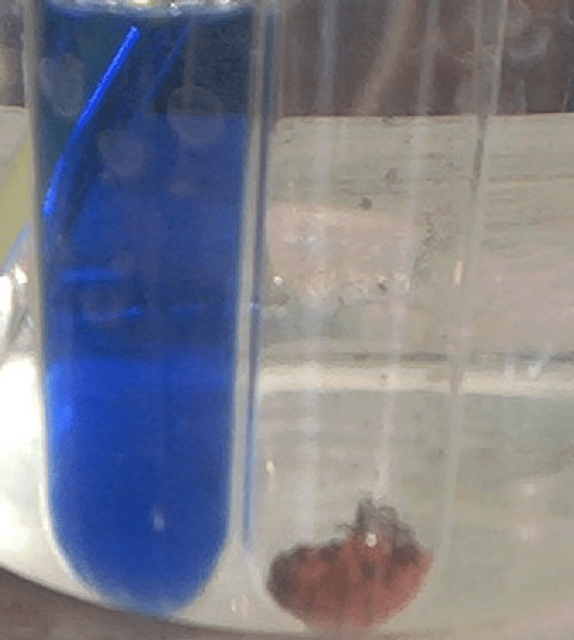Fehling's solution

Fehling's solution

| Classification | Colorimetric method |
|---|---|
| Analytes | Monosaccharides |
Fehling's solution is a chemical reagent used to differentiate between water-soluble carbohydrate and ketone functional groups, and as a test for reducing sugars and non-reducing sugars, supplementary to the Tollens' reagent test. The test was developed by German chemist Hermann von Fehling in 1849.[1] But the solution has a drawback as it cannot differentiate between benzaldehyde and acetone.
| Classification | Colorimetric method |
|---|---|
| Analytes | Monosaccharides |
Laboratory preparation
Fehling's solution is prepared by combining two separate solutions, known as Fehling's A and Fehling's B. Fehling's A is aqueous solution of copper(II) sulfate, which is deep blue. Fehling's B is a colorless solution of aqueous potassium sodium tartrate (also known as Rochelle salt) made in a strong alkali, commonly with sodium hydroxide. Typically, the L-tartrate salt is used. The copper(II) complex in Fehling's solution is an oxidizing agent and the active reagent in the test.
The deep blue active ingredient in Fehling's solution is the bis(tartrate) complex of Cu2+. The tartrate tetraanions serve as bidentate alkoxide ligands.[2]
Preparation of Fehling’s reagent: It is a mixture of copper sulfate solution (solution A) and alkaline sodium-potassium tartrate solution (solution B). The solutions A and B are prepared as described below. 'Solution A' Dissolve 34.65 g of copper sulfate (cupric sulfate) in 500 ml of distilled water and make the final volume 500 ml with distilled water. Solution B (Alkaline sodium-potassium tartrate solution): Dissolve 125 g of KOH and 173 g of sodium-potassium tartrate (Rochelle salt) in 400 ml of distilled water and make the final volume 500 ml with distilled water. Both solutions A & B are prepared separately and stored in rubber stoppered bottles. Whenever required, the Fehling’s reagent is prepared fresh by mixing equal volumes of solution A and B. (Ref: Chapter 48 in Essentials of Practical Biochemistry, Prem Prakash & Neelu Gupta, Jaypee Brothers Medical Publishers, Ltd)
Use of the reagent
Fehling's solution can be used to distinguish aldehyde vs ketone functional groups. The compound to be tested is added to the Fehling's solution and the mixture is heated. Aldehydes are oxidized, giving a positive result, but ketones do not react, unless they are α-hydroxy ketones. The bistartratocuprate(II) complex oxidizes the aldehyde to a carboxylate anion, and in the process the copper(II) ions of the complex are reduced to copper(I) ions. Red copper(I) oxide then precipitates out of the reaction mixture, which indicates a positive result i.e. that redox has taken place (this is the same positive result as with Benedict's solution).
Fehling's test can be used as a generic test for monosaccharides and other reducing sugars (e.g., maltose). It will give a positive result for aldose monosaccharides (due to the oxidisable aldehyde group) but also for ketose monosaccharides, as they are converted to aldoses by the base in the reagent, and then give a positive result.[3]
Fehling's can be used to screen for glucose in urine, thus detecting diabetes. Another use is in the breakdown of starch to convert it to glucose syrup and maltodextrins in order to measure the amount of reducing sugar, thus revealing the dextrose equivalent (DE) of the starch sugar.
Formic acid (HCO2H) also gives a positive Fehling's test result, as it does with Tollens' test and Benedict's test also. The positive tests are consistent with it being readily oxidizable to carbon dioxide.
Net reaction
The net reaction between an aldehyde and the copper(II) ions in Fehling's solution may be written as:
- RCHO + 2 Cu2+
- 5 OH
- Cu
or with the tartrate included:
- RCHO + 2 Cu(C4H4O6)22−
- 5 OH
- Cu
- 3 H
Safety
Sodium hydroxide is corrosive.[3]
See also
Barfoed's test
